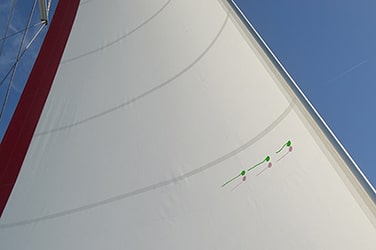
This article is an excerpt from NauticEd’s online FREE Basic Sail Trim Course, an interactive online sailing course for beginner to intermediate sailors to learn the basics of sail trim. Or if you want to learn more, upgrade to the Skipper Course Bundle to become a competent sailor!
You can learn to sail and improve your sailing with NauticEd, the international leader in sailing education.
Terms Port – Starboard – Forward – Aft
In discussing sail trim, certain terminologies must be understood and so we are presenting a few basics so it will help you later.
Port and Starboard
When facing forward, the port side is on the left and the starboard side is on the right. Port and left have the same number of letters – that makes it easy to remember.
If you look at the front of any boat in the world, you will see a red light on the port side and a green light on the starboard side. These colors are by global convention and are the same on every boat in the world. To remember this, use the mnemonic:
“Is there any red-port-left?”
Besides the reference to delicious after-dinner drinks from Portugal — the country whose sailors invented world discovery — the phrase reminds us that a red light is always on the port side and the port side is on the left. Remember this phrase well. You will use it often for the rest of your sailing life and is universal globally for all boats. Consequently, a green light is always on the right side which is the starboard side of the boat.
On-Port and On-Starboard
These are very important sailing angles to the wind. When sailing, you are either on a port tack – “on-port”, or on a starboard tack – “on-starboard”. More on this in the sailing module and the rules module, but here is a quick intro to these terms of sailing angle for now:
- On-port means the wind is coming from the port side of the boat
- On-starboard means the wind is coming from the starboard side of the boat
Below, red (boat on left) has the wind on his own boat coming from the port side of his own boat – he is “on-port”. Blue (boat on right) has the wind on her own boat coming from the starboard side of her own boat – she is “on-starboard”. Being ‘on port’ or ‘on starboard’ has nothing to do with the other boat – it is all about how the wind is approaching your own boat.

Forward and Aft
Not too much explanation is required other than to say they are directions not points on the boat. For example, if you say forward that is a direction toward the front of the boat. If you say aft, that is in a direction toward the back of the boat.

Abeam
Abeam is at an angle towards and beyond the widest side part of the boat. Commonly you will add port or starboard to “abeam”. For example. “the lighthouse is port abeam”.
All the angles extend from the center of the boat and beyond – meaning you could say “There is a boat 100 meters aft” or “There is a rock 50 meters abeam to starboard” or on the boat you could say “the spare winch handle is down in the forward port locker”.
Astern
Astern is essentially the same as “aft” except that astern means beyond the confines of the boat and is directly behind the boat. “The boat astern is gaining on us” – this means there is a boat behind us and catching up to us.
Learn Basic Sail Trim for FREE...
A FREE 1-2 hour course that teaches how to work with sails to get your boat moving. The free Basic Sail Trim Course is for any aspiring sailor as well as experienced sailors wanting to learn more. Or, consider upgrading to the Skipper Course Bundle to become a fully competent skipper!
